

Topic 3: Energy Systems - IB. Physical Educ8or: IB SEHS: Nutrition. Physical Educ8or: IB SEHS: Carbohydrate and Fat Metabolism. Physical Educ8or: IB SEHS: Nutrition and Energy Systems. VCE PE. Carbohydrates. Condensation Reaction. A condensation reaction occurs when two molecules join to form a larger molecule and release a smaller molecule(s) in the process.
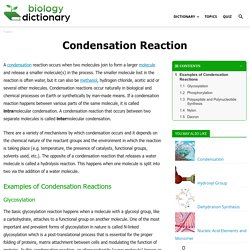
The smaller molecule lost in the reaction is often water, but it can also be methanol, hydrogen chloride, acetic acid or several other molecules. Condensation reactions occur naturally in biological and chemical processes on Earth or synthetically by man-made means. If a condensation reaction happens between various parts of the same molecule, it is called intramolecular condensation. A condensation reaction that occurs between two separate molecules is called intermolecular condensation. There are a variety of mechanisms by which condensation occurs and it depends on the chemical nature of the reactant groups and the environment in which the reaction is taking place (e.g. temperature, the presence of catalysts, functional groups, solvents used, etc.). Glycosylation Phosphorylation. Molecular structure of glucose. 3.1.5 - Condensation and Hydrolysis. Glucose Structure Memory Trick. Biochemistry of Carbohydrates.
Explainer: what are trans fats? Trans fats – they’re in our chips, bakery goods, popcorn and cakes.

We know we should avoid them, but what exactly are they, and why are they so bad for us? First, let’s take a step back and look at how trans fats fit into the two broad categories of edible fats: saturated and unsaturated. What are saturated fats? Saturated fats have a stable chemical composition – they’re solid at room temperature and oxidise slowly. Because they’re very stable and feel good in the mouth, they’re commonly added to processed foods. Health wise, saturated fats raise the level of cholesterol in the blood. Animal fats – cream, butter and milk – tend to be at least a half saturated fat. Lipids. Fat. Fat are an essential part of our diet and is important for good health.
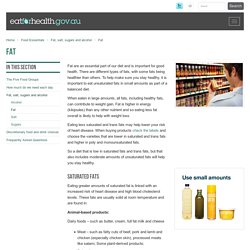
There are different types of fats, with some fats being healthier than others. To help make sure you stay healthy, it is important to eat unsaturated fats in small amounts as part of a balanced diet. Proteins. What Are Trans Fats, and Are They Bad for You? You may have heard a lot about trans fats.

These fats are notoriously unhealthy, but you may not know why. Although intake has declined in recent years as awareness has increased and regulators have restricted their use, trans fats still pose a public health problem. This article explains everything you need to know about trans fats. Nonessential Amino Acid - an overview. Serine Serine is non-essential amino acid supplied from food or synthesized by the body from a number of metabolites, including glycine.
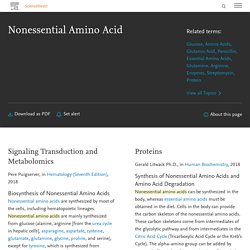
Serine is found in soybeans, nuts (especially peanuts, almonds, and walnuts), eggs, chickpeas, lentils, meat, and fish (especially shellfish). Serine is produced by the body when insufficient amounts are ingested. Amino acids: MedlinePlus Medical Encyclopedia. Putting it all together. Essential Amino Acids: Definition, and Functions. Definitions of Essential Amino Acids Amino acids are the smallest unit of protein and can be defined as an organic molecule made up of amine and carboxylic acid functional groups—an amino acid is composed of nitrogen, carbon, oxygen, and hydrogen molecules.
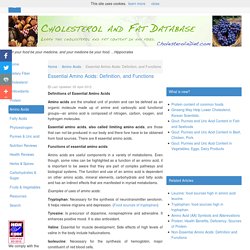
Essential amino acids, also called limiting amino acids, are those that can not be produced in our body and there fore have to be obtained from food sources. There are 8 essential amino acids. Functions of essential amino acids. Overview of Amino Acid Metabolism. Biomolecules (Macronutrients) How Your Body Uses Carbs and Fats for Energy – Enzymedica. One of the timeless comparisons we are told growing up is that our body is like a machine.
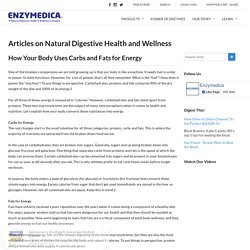
It needs fuel in order to power its daily functions. However, for a lot of people, that’s all they remember. What is the “fuel”? How does it power the “machine”? Australian Guide to Healthy Eating. Recommended number of serves for children, adolescents and toddlers. Healthy diet. Overview Consuming a healthy diet throughout the life-course helps to prevent malnutrition in all its forms as well as a range of noncommunicable diseases (NCDs) and conditions.
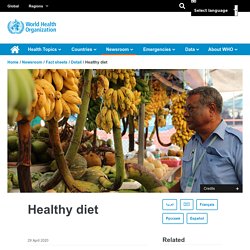
However, increased production of processed foods, rapid urbanization and changing lifestyles have led to a shift in dietary patterns. People are now consuming more foods high in energy, fats, free sugars and salt/sodium, and many people do not eat enough fruit, vegetables and other dietary fibre such as whole grains. The exact make-up of a diversified, balanced and healthy diet will vary depending on individual characteristics (e.g. age, gender, lifestyle and degree of physical activity), cultural context, locally available foods and dietary customs. However, the basic principles of what constitutes a healthy diet remain the same. For adults A healthy diet includes the following: For infants and young children Practical advice on maintaining a healthy diet. Sporting performance and food. Daily training diet requirements The link between good health and good nutrition is well established.
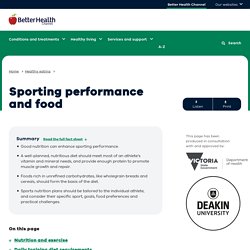
Interest in nutrition and its impact on sporting performance is now a science in itself. Whether you are a competing athlete, a weekend sports player or a dedicated daily exerciser, the foundation to improved performance is a nutritionally adequate diet. Biological Molecules - You Are What You Eat: Biology #3. Anabolism vs Catabolism. Anabolic and Catabolic Processes Anabolic processes use simple molecules within the organism to create more complex and specialized compounds.
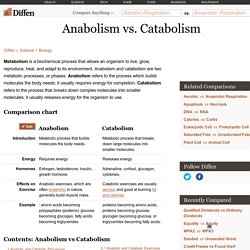
This synthesis, the creation of a product from a series of components, is why anabolism is also called "biosynthesis. " The process uses energy to create its end products, which the organism can use to sustain itself, grow, heal, reproduce or adjust to changes in its environment. Growing in height and muscle mass are two basic anabolic processes. At the cellular level, anabolic processes can use small molecules called monomers to build polymers, resulting in often highly complex molecules. Catabolic processes break down complex compounds and molecules to release energy. The principal catabolic process is digestion, where nutrient substances are ingested and broken down into simpler components for the body to use. Hormones Many of the metabolic processes in an organism are regulated by chemical compounds called hormones.
Anabolic hormones include: Basics of Metabolism. Overview of metabolism: Anabolism and catabolism. 3.2.6/3.2.7 - What is glucagon? Role of insulin. Glucose Insulin and Diabetes. Eukaryopolis - The City of Animal Cells: Crash Course Biology #4. ATP & Respiration: Biology #7. Cellular Respiration. Introduction to Cellular Respiration. Oxidative Phosphorylation: The major energy provider of the cell (article)
Cellular Respiration and the Mighty Mitochondria. Aerobic System (Aerobic glycolysis).wmv. Anaerobic System (Anaerobic glycolysis) Cellular Respiration - Biology LibreTexts. Life is possible only if molecules and cells remain organized. Organization requires energy, as governed by the laws of thermodynamics. Just about anything a living organism does requires energy. We most often think of energy as food or calories. Cells, however, think of energy as ATP. Cellular respiration is the process of taking the food we eat (like sugar) and converting it into an energy that can be used by cells - ATP. The breakdown of energy rich molecules like glucose to obtain energy is called cellular respiration.
Figure . There are 3 important stages of celluar respiration: 1. 2. 3. Important Players in Cellular Respiration Glucose: A simple, 6 carbon sugar that serves as the primary energy source in the body. ATP (Adenosine triphosphate): The major energy currency of the cell. NADH: High energy electron carrier used to transport electrons generated in Glycolysis and Krebs Cycle to the Electron Transport Chain. FADH2 & NADH: Definition & Overview - Video & Lesson Transcript. Krebs Cycle: An Overview. MRC Mitochondrial Biology Unit. The Muscular System and Energy. Energy Systems. Energy Systems - ATP Energy In The Body - Adenosine Triphosphate - Glycolysis. Oxidisation - Dictionary Definition. Oxidation of Glucose and Fatty Acids to CO2 - Molecular Cell Biology - NCBI Bookshelf.
Overview of Fatty Acid Oxidation. Fatty Acid Oxidation - Part I. Fatty Acid Oxidation - Part II. What is EPOC (Excess Post Exercise Oxygen Consumption) Gatorade Sports Science Institute. Introduction to Sports Nutrition.